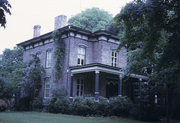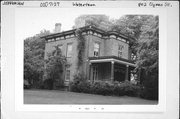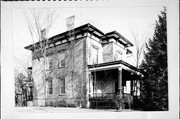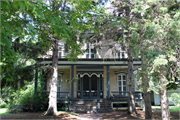Property Record
802 Clyman St.
Architecture and History Inventory
| Historic Name: | Theodore Prentiss House |
|---|---|
| Other Name: | |
| Contributing: | Yes |
| Reference Number: | 7137 |
| Location (Address): | 802 Clyman St. |
|---|---|
| County: | Jefferson |
| City: | Watertown |
| Township/Village: | |
| Unincorporated Community: | |
| Town: | |
| Range: | |
| Direction: | |
| Section: | |
| Quarter Section: | |
| Quarter/Quarter Section: |
| Year Built: | 1855 |
|---|---|
| Additions: | |
| Survey Date: | 1986 |
| Historic Use: | house |
| Architectural Style: | Italianate |
| Structural System: | |
| Wall Material: | Cream Brick |
| Architect: | |
| Other Buildings On Site: | |
| Demolished?: | No |
| Demolished Date: |
| National/State Register Listing Name: | Clyman Street Historic District |
|---|---|
| National Register Listing Date: | 8/3/2015 |
| State Register Listing Date: | 2/27/2015 |
| National Register Multiple Property Name: |
| Additional Information: | This was the home of pioneer attorney Theodore Prentiss between the 1860s and around 1910. Prentiss' son James, then lived in the house until at least 1930. Theodore Prentiss was a native Vermonter, educated at the University of Vermont. He was admitted to the bar in 1844 and immediately came west, arriving in Watertown in 1845. He practiced law here for 20 years and also engaged in real estate, railroad, banking, and other business enterprises. He became so successful he eventually left the law practice to put his full time into his business interests. Prentiss achieved lasting fame as the first mayor of Watertown. he also served as mayor in 1872-73. Prentiss attended the first and second Wisconsin constitutional conventions in 1846 and 1847 and was a member of the state assembly in 1860 and 1861. James Prentiss was involved in insurance and real estate businesses and by 1930 was the Vice President of the Bank of Watertown. This house is significant for local history because it was associated with important pioneer attorney, Theodore Prentiss. Prentiss was important to the community of Watertown because he helped guide it during its early years as mayor, and he invested in businesses that helped provide an economic base for the community. His work at the state level in the constitutional conventions and the assembly also makes his career an important one in Watertown. Prentiss' office building on Main Street still stands, with some loss of integrity. However, because of his long-term residency in this house, it is significant for its association with him. The house also has some historic interest as the home of James Prentiss, a prominent businessman in his own right during the twentieth century. A cream brick Italianate house built in 1855 for Watertown's first mayor, Theodore Prentiss, this rectangular house has wide eaves supported by large brackets, tall thin floor windows and a low pitched roof. Triangular pediment shaped projecting window heads and a projecting entrance bay in the center of the facade featuring a projecting triple arched entrance with doors featuring etched glass further characterize this elegant house. A frieze ornamented with classical wreath and open flat roofed front and rear porches with paneled post and balustrade are also located on the house. A sidewalk of brick with a pressed geometric design laid in the 19th century remains on the property. The Theodore Prentiss house is an excellent example of the Italianate style. One of the very best examples of the Italianate style remaining in the city, the Prentiss House is characterized by the low pitched roof, the overhanging eaves with brackets and ornamental frieze, the entrance bay and the articulated window heads over long floor windows that clearly identifies the style of the house as Italianate. The other significant examples of the Italianate style are the Cole house at 802 N. 4th (28-22), the vernacular house at 413 S. 6th (40-26) and 307 West Cady, the Kusel house at 216 N. Church (54-15), the Hartwig house at 903 County Lane (27-32), and the Hill house at 700 Clyman (43-25). |
|---|---|
| Bibliographic References: | (A) Evelyn Ruddick Rose, Our Heritage of Homes (Watertown Historical Society, 1980), pp. 74-75. (B) Watertown City Directories, 1866-1930, Watertown, Wisconsin Public Library. (C) Butterfield, C.W., The History of Jefferson County, Wisconsin, Chicago: Western Historical Company, 1879, p. 621. |
| Wisconsin Architecture and History Inventory, State Historic Preservation Office, Wisconsin Historical Society, Madison, Wisconsin |




